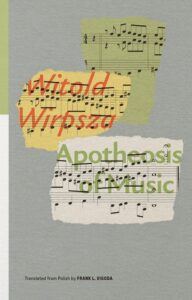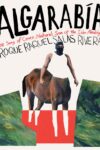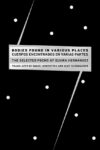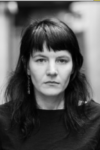
[World Poetry Books; 2025]
Tr. from the Polish by Frank L. Vigoda
“God’s / Fingers… resemble the fingers of a pianist,” writes the Polish poet Witold Wirpsza. In Apotheosis of Music, translated by Frank Vigoda, religion and music blend, or deeply merge, in poetry that explores God, war, death, and life through the terminology of an orchestra. For Wirpsza, a fugue can be a person, notes can be nails that stick in one’s head, and God himself can play the piano of humankind, becoming the maestro of creation.
The dictionary definition of an “apotheosis” is: the highest point in the development of something; a culmination or climax; the elevation of someone to divine status. In Apotheosis of Music by Witold Wirpsza, music becomes a symbol of the most perfect iteration of beauty itself, and when blended with the written word, allows the poetic form to achieve a kind of apotheosis of its own. Descriptions of pictures and portraits, both physical and figurative, become like notes and sheet music, stripping things down to their most basic and raw level.
When first encountering the work, the title was what struck me. I am a lover of music, both classical and modern. I often see parallels between written work and musical pieces, and believe that each can work as inspiration for the other. Audio can create a world and conjure up images as powerful as any that words can paint, often touching an emotional place that writing cannot. Poetry, the original form of song lyrics, has long been put to music and been intertwined with musical composition, but this is the first full collection I read that makes that tie explicitly clear.
I had never read any Polish work before, and was glad to be expanding my knowledge of world literature with this collection. I found that the works of different lengths were well varied to create a balanced collection. I also appreciated the introduction, which provided vital context about the author and the Poland from which he came. Without the introduction I feel the meaning of the poems would have diminished slightly, as I would have been left with more questions than answers about them.
The tempo and the rhythm in these poems are unlike anything I have ever read. As someone who struggles with identifying meter and other such elements in poetry, I found myself reading these poems as I would read song lyrics, with a beat that exists alongside the words rather than transposed onto them. The longer lines are able to take their time and proliferate their meaning in the reader’s mind, while the shorter lines act like staccato beats of a song, interrupting more languid moments with a sense of urgency. Different poems themselves follow this pattern as well, as Wirpsza’s shorter works often carry pointed messages about politics or justice, and they appear between his longer works about topics like music or the artistic mind.
The compilers make the choice to place the original Polish text beside the English translation. Though I cannot read or understand any Polish, I do appreciate this effort to show that the English version is not the only version, and in fact is not the most accurate version, since the purest form of the poems will always be found in their native language. As the daughter of a native Spanish speaker, I have long been told that I am “missing things” when I read Spanish literature that has been translated into English. Seeing the two poems side by side brings into the conversation and the reading experience the act of translation itself. It allows the reader to ponder what has perhaps been lost in the translations of the poems, and the more careful and observant readers can notice slight differences in line lengths and breaks between the Polish and the English.
In one musical self portrait, which appears in the poem “Self Portrait (Rather Sightless),” the poet likens musical composition to visual artistic creation. He also likens music to photography and people’s likenesses. In other poems, music is also connected to dance, as it is the bodily expression and reaction to music itself. In numerous cultures, dance is tied to ritual and celebration, and Wirpsza does the same by incorporating the practice into poems that celebrate the triumph of life over death, of joy over grief, of happiness over fear.
In the poem “Apotheosis of the Dance,” Wirpsza places historical figures like Beethoven and Plato in semi-modern contexts, juxtaposed with a section about a knight from the medieval era dancing ‘foolishly,’ almost as if in resistance to every day routine life. Dance becomes a physical form of endurance against major grief, a subject that Wirpsza handles deftly and pointedly. He tackles the immense despair that befell not only his country, but the entire world after WWII. His emphasis on the difference between dark and light, and his depiction of painters and artistic self representation, might suggest a personal reclaiming of the light from the overwhelming darkness of wartime. He plays with history and historical figures, blurring the line between fact and fiction. He places historical figures in Polish contexts, conjuring up ideas and words for them, allowing them to revel with one another despite their separation by time and space. Some of these historical figures are philosophers, such as Plato and Dante, and he uses that to further draw a connection between music and philosophy. These are two powerful capabilities of the human mind and human thought, and as Wirpsza draws a parallel between the two, it allows the reader to see both in a completely new way. We are almost forced to reassess what we think about music and philosophical thought, and how one can bear on the other. A metaphor that occurs a few times throughout the collection, in which he likens musical notes to nails for the way that they stick in people’s heads, might also connect to the clear link Wirpsza sees between music and human thought.
On the subject of human ways of thinking, there is a clear allusion to religion and religious ideals in many of the poems, often in a manner that would likely have read as subversive or controversial to his original audience. For example, Wirpza asks readers in the poem “No Paradise,” “Does being happy / Mean losing the soul?” interrogating the common image of the Garden of Eden as a paradiso to which all will eventually return. Yet, in that same poem he still leaves readers with the message “Heaven / Love, and happiness have no exits” describing the fullness of the nature of joy is when it has reached its highest point, its apotheosis.
That theme is what I took away from this collection upon completing it. I was reminded of the universality and timelessness of music and music making, and how it has been an outlet for expression long before the modern music industry. It vindicated me in some ways, since I have always professed a strong belief in the connection between music and writing, and many ideas for my own work start from music. I also think we have forgotten, in an era that often separates the two, that poetry was the first version of lyrics. Wirpsza is quick to remind us of this, showing that music can be used to heal, serve as a form of activism, and warn.
Apotheosis of Music by Witold Wirpsza is an intricate and detailed collection. The poet handles pertinent topics from his time in a way that makes them endlessly applicable. The ordering of this collection allows audiences to infer that Wirpsza believed music achieved its own apotheosis by being weaved into his poetic works, crystalizing music into the tangible ink and paper of written word. Wirpsza applies music and musical composition to important topics like religion and grief. The collection leaves readers with a better understanding of what music means to us as a collective humanity.
Danielle Bartholet is a third-year Writing, Literature, and Publishing student at Emerson College in Boston, Massachusetts. Originally from Houston, TX, her work has appeared in Houston Family Magazine, and Black Swan Literary Magazine, as well as other literary magazines of Emerson. She works as an assistant editor for The Berkeley Beacon, her college’s only student run newspaper, writing arts and culture coverage such as theatrical features and book reviews. Her work has won Gold and Silver Keys from the Scholastic Art and Writing awards, and her original poem “Rays of Old” was anthologized in the publication Collecting Dust: Fresh Voices in Short Fiction and Poetry (2022). When not writing, she enjoys making and posting online reviews of local coffee shops on her social media, as part of her “Coffee and Cars” video series, as well as traveling and attending the theatre.
This post may contain affiliate links.






